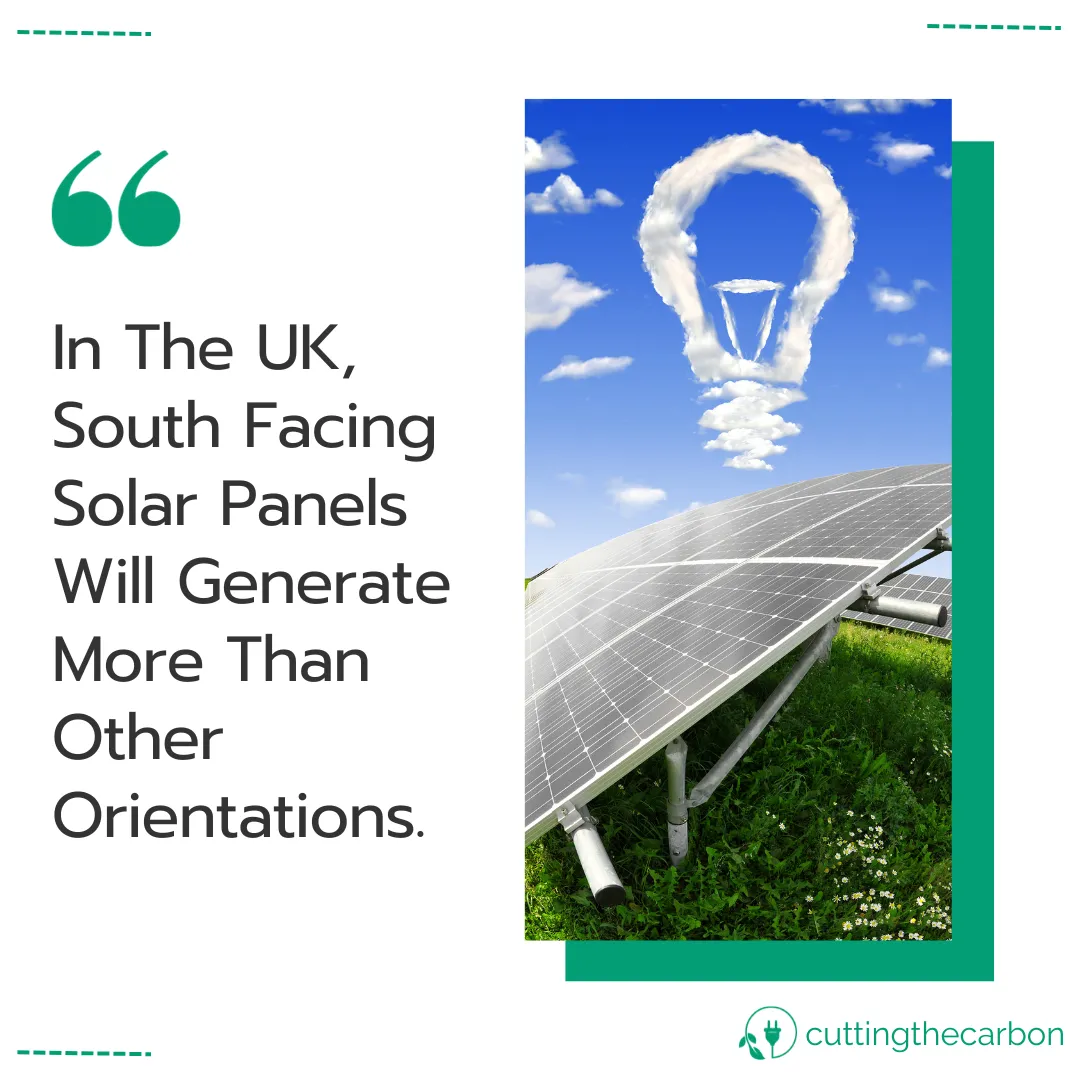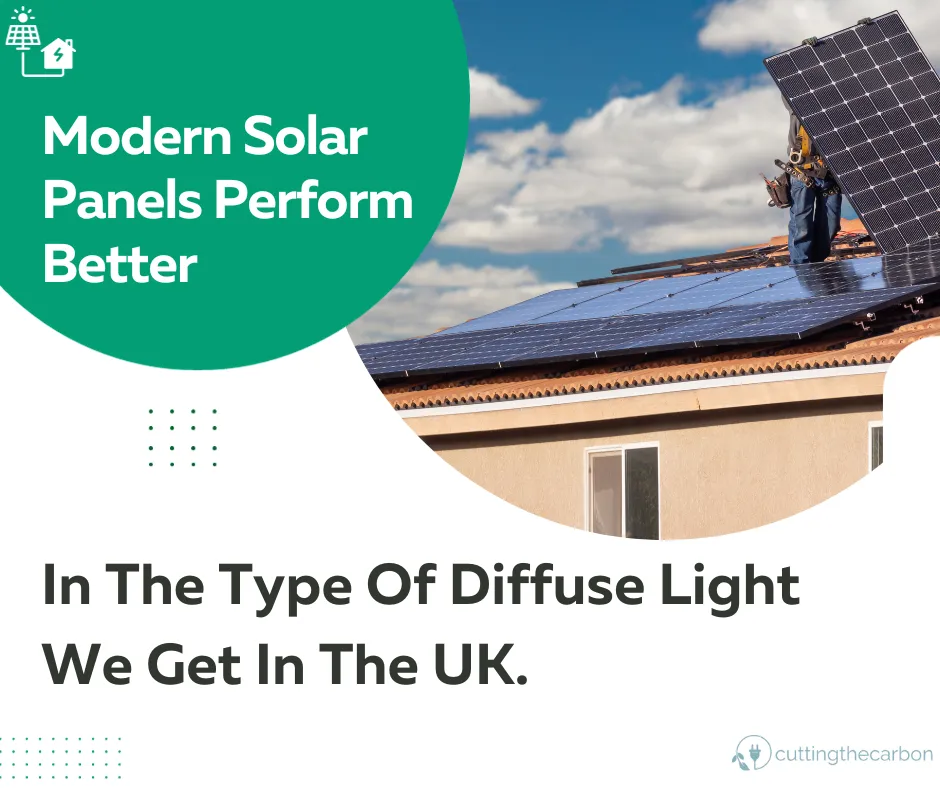Which way should a solar panel face? It’s a commonly asked question for those interested in embracing solar panel energy.
The answer, though seemingly simple, can make or break the efficiency of your solar energy system. After all, getting it right means maximising renewable power generation and reducing energy bills.
You might think pointing them towards the sun is enough. But there’s more to it than meets the eye when deciding which direction your panels should point.
Solar Panels Orientation And Efficiency
| Aspect | Description |
|---|---|
| Optimal Orientation | South facing panels generate more electricity than other orientations. |
| Sun Exposure | Panels perform best when the sun shines directly on them. At an angle, they are less effective. |
| Sun Movement | The sun moves from East to West, being higher in summer and lower in winter. |
| Efficiency: SE and SW | Can generate around 94% of the electricity a South facing installation would. |
| Efficiency: East / West | Can generate around 80% of the maximum. |
| Roof Elevation | Assumed at 40° for calculations. Lower pitches perform slightly better for East / West facing. Higher pitches increase the difference. |
| Example: SW Facing in London | Outperforms the generation used in models for returns from well-sited solar in the UK. Generates marginally more than a similar South facing system in Edinburgh. |
| Direction as a Factor | It is important, but only one of many factors. Even non-South-facing roofs can benefit from solar PV. |
| Site Assessment | Is necessary for an accurate picture of generation potential, savings, and income. |
| Recommendation | Get information and quotes from 3 or more accredited installers. |
The Importance of Solar Panel Orientation in the UK
When it comes to harnessing solar power, orientation is a key player. The direction your solar panels face can immensely impact their efficiency and energy production capabilities.
In the United Kingdom, south-facing roofs are prime real estate for installing solar PV systems slightly tilted towards the sun. They receive maximum sunlight throughout most parts of the day, which translates into optimal performance from your solar panels.
There’s no need to worry if you’re dealing with east or west-facing roofs due to architectural constraints or design preferences. These orientations may not catch as much peak sunshine as perfectly positioned south-facing arrays, but they still hold the potential for generating renewable energy.

East vs West: A Comparative Analysis
An east-oriented panel catches morning light effectively, while its western counterpart does well with afternoon rays up until the setting sun. However, these setups perform less efficiently than those facing directly South because they get fewer hours of direct sunlight overall.
This doesn’t mean that non-south-oriented installations aren’t worth considering – far from it. With careful planning and possibly additional units installed compared to equivalent southern setups, similar output levels could be achieved over time.
Picking Experienced Solar Panel Installers: Why It Matters?
When executing projects, selecting experienced installers who take factors such as site assessment, savings potential, and the right products and service price into account can make all the difference between success and failure.
Your installer should also consider income generation possibilities associated with installation to help ensure return investment is maximised in every possible way.
Understanding Solar Panel Efficiency
Solar panel efficiency is a significant aspect that determines the conversion rate of sunlight into usable electricity. Polycrystalline and monocrystalline are the two main types of solar panels available in today’s market.
The polycrystalline variety, made from multiple silicon fragments fused together, tends to be more affordable due to their cheaper production costs. However, they offer lower efficiency rates, between 15% and 17%, as less pure silicon is used in their manufacturing process.
In contrast, monocrystalline solar panels use single-crystal structures, providing better flow for electrons, resulting in higher efficiencies ranging from 20% to 22%. Despite being pricier than polycrystalline because of this superior performance metric, homeowners often consider it worth investing in for increased energy yield.
What’s The Best Solar Panel Orientation Video Guide
Choosing Efficient Panels for Your Home
Selecting efficient solar panels primarily depends on your unique needs and circumstances. For instance, budget constraints may lead some households to choose cost-effective polycrystals despite slightly lower performance metrics.
If you’re focusing on long-term benefits, though – especially if residing in an area with high sunshine levels – opting for monocrystalline could result in substantial savings through reduced bills over time. This resource offers further insights into making this pivotal decision based on individual situations.
- Type Isn’t Everything:
While type plays a considerable role in overall system performance, factors like installation quality and solar panel orientation also significantly contribute to achieving optimal results in green technology investments.
It’s here where experienced installers come in handy who ensure proper product placement and conduct comprehensive site assessments considering potential income generation along with expected savings when installing these sustainable power sources within homes or commercial premises.
This holistic approach helps tailor the best possible solutions to specific customer requirements, ensuring maximum returns on investment.
Getting your solar panel’s bang for the buck boils down to a few key factors. The type of panel – polycrystalline or monocrystalline – plays a role, but don’t overlook installation quality and orientation. Remember, it’s not just about upfront costs; think long-term savings too.
The Science Behind Solar Panel Installation
Understanding the science behind solar panel installation is essential to maximising your green energy production. For instance, your location’s latitude significantly influences the optimal angle at which you should install your panels.
If we consider a UK location with a latitude of 50 degrees, tilting solar panels equal to this or between 50 and 65 degrees can provide efficient year-round kWp power generation. This is due to seasonal variations in the sun’s position – higher during summer months and lower in winter – requiring appropriate adjustments in tilt angles.

Why Direction Matters More Than Angle
You might be wondering: How does direction factor into all this? It is even more crucial than angle when installing solar PV systems slightly tilted towards south-facing roof areas.
Solar panels facing south are exposed directly to sunlight throughout most parts of the day, making them perform optimally.
But that doesn’t mean other orientations aren’t viable; east- or west-facing installations will still produce electricity, albeit less efficiently, because they face either the rising or setting sun.
To get maximum performance from installed solar arrays, ensure they face south whenever possible, but remember – non-south facing installations designed by experienced installers considering factors like site assessment can also generate substantial amounts of clean energy.
Exploring Roof Design and Solar Panel Placement
Your roof design is a significant factor when considering solar panel installation. For instance, flat roofs offer great flexibility, allowing panels to be installed at any angle or direction. However, this type of structure isn’t common in all homes.
In such cases, installers must maximise the available space while ensuring optimal performance from your solar power system.
Ground-Mounted Solar Panels as an Alternative Solution
If your home’s roof doesn’t lend itself well to solar panel installations because of its design or other factors like shading by nearby trees or buildings, there’s no need for concern. Ground-mounted solar panels could provide just the solution you’re looking for.
- The main advantage of ground-mounted systems is greater control over both orientation (ideally south-facing) and tilt angle, which ensures maximum sunlight exposure throughout the day. This potentially makes them even more efficient than rooftop installations.
- Beyond offering better positioning options, these systems also facilitate easier access for maintenance tasks compared with rooftop setups – climbing onto roofs might not be everyone’s cup of tea.
The Benefits of South-Facing Solar Panels
Optimally oriented solar panels in the UK should face southward to maximize sunlight absorption and, consequently, electricity production. This direction allows your panels to soak up maximum sunlight throughout the day, generating higher electricity than other orientations.
A roof facing due south receives optimal sun exposure because it’s directly aligned with our sun at its zenith. Consequently, these well-positioned panels can absorb and convert more energy into usable power compared to those on east or west aspects.
Performance Comparison Between Different Orientations
You might wonder how much difference there is between a perfectly south-oriented array and one facing southeast (SE) or southwest (SW). Even under ideal conditions, SE/SW arrays still perform admirably – generating around 94% of what their southern counterparts do.
This slight drop-off shouldn’t deter you from installing solar PV if your property doesn’t have an ideally exposed southerly aspect. The slight efficiency loss when comparing SE/SW and perfect southern alignment translates only marginally less energy production over time.
Suppose we venture further from this optimal directionality towards east/west-oriented rooftops. In that case, performance does decrease slightly again – down to about 80% of what a similar-sized system would generate on a true southern aspect.
However, before deciding where it is best to place your new panels, remember always to consider, first and foremost, your household’s specific needs.
No matter which way they face, though, rest assured investing in high-quality, efficient panels will help maximise savings on energy bills whilst reducing carbon emissions.
Choosing Experienced Solar Panel Installers
The journey towards sustainable energy can seem daunting, but the challenges homeowners face today are pretty simple to overcome with experienced solar panel installers. These professionals understand the technical aspects of installing solar panels and consider site assessment, potential savings and income generation factors.
Finding a Professional Who Understands Your Site
A thorough site assessment involves evaluating the orientation of your roof, its slope and any potential shading issues. How do you go about finding an installer who understands these complexities?
It is all about choosing someone with comprehensive knowledge who will be able to provide accurate estimates based on these considerations.
Your solar panels’ performance depends heavily on this initial step – it forms the foundation for everything else.
Selecting Efficient Panels Suited For You
To make sure you’re getting value from your investment, it needs to be good. This isn’t overly complicated when working with experts in green technology solutions.
- An experienced installer has a broad understanding of various types of efficient panels available in the market, like monocrystalline or polycrystalline ones, which suit specific household needs & budget constraints.
- This expertise ensures investing wisely into a system designed for optimal performance now & future years.
- Avoid common mistakes made by inexperienced people – let the pros handle installation while guiding you through the process smoothly.
Pricing Fairly And Providing Quality Service
In addition to product selection & technical know-how, competitive pricing without compromising service quality separates quality companies from the rest. Their reputation hinges upon customer satisfaction; hence, they strive to deliver excellent service from consultation to aftercare support.
They do not just sell products but offer long-term value, helping customers maximise their returns whilst contributing positively towards environmental sustainability goals. All pieces should align perfectly with strategy so one does not miss out on crucial steps during the execution procedure.
Embarking on the path to sustainable energy is a breeze with experienced solar panel installers. They ace in technical know-how, site assessment and choosing efficient panels tailored to your needs. Moreover, they ensure fair pricing without skimping on quality service – it’s not just about selling products but offering long-term value and environmental sustainability.
FAQs Concerning Which Way Should a Solar Panel Face
Should solar panels face west or east?
Solar panels can also be oriented towards the east or west. However, this will yield around 80% of what a south-facing installation would generate.
What is the best direction for solar panels to face?
The optimal direction for solar panel placement is generally south. This ensures they capture maximum sunlight throughout the day.
Do solar panels need to face a certain way?
Yes, orientation impacts efficiency. Solar panels perform best when facing towards the equator, which in the case of the UK means facing southwards.
My Closing Thoughts
Maximising your solar panels’ output is a question of direction and inclination. Solar panel orientation can make or break your energy production in the UK—a south-facing roof soaks up maximum sunlight throughout the day.
Yet, don’t despair if you’re dealing with east or west-facing roofs – they still pack quite a punch.
Different types of solar panels come into play, too, with monocrystalline models leading in efficiency despite their higher price tag compared to polycrystalline alternatives.
Your geographical latitude helps determine the best tilt for your panels. And remember: direction often trumps angle when it comes to maximising output.
Rooftop design poses another challenge, but ground-mounted systems offer flexibility where rooftops may fall short.
Finally, choosing experienced installers ensures that all factors are considered – from site assessment and savings potential to product selection. Ready to harness renewable power and slash those energy bills? Let Cuttingthecarbon guide you on this journey towards greener living.

